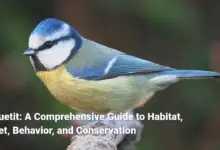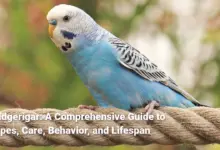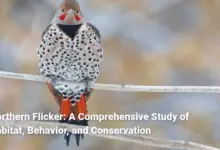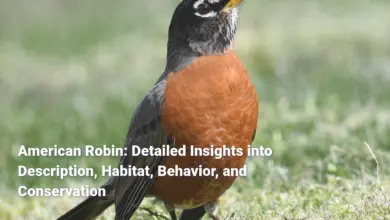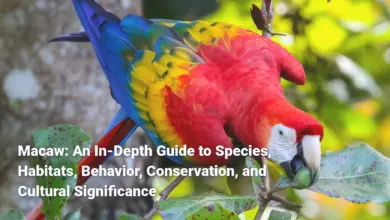Amazon Parrot: Characteristics, Habitat, Behavior, Diet, and Care
Amazon parrots are widely recognized for their vibrant colors and engaging personalities, making them one of the most beloved bird species among pet owners and avian enthusiasts alike. These remarkable birds originate from the lush forests and tropical environments of Central and South America, and they have captivated the hearts of many due to their intelligence, social behaviors, and exceptional vocal abilities. Owning an Amazon parrot can bring joy and companionship; however, it also comes with responsibilities and challenges that potential owners must consider thoroughly. Understanding the characteristics, behaviors, dietary requirements, and care needed to ensure a healthy and happy Amazon parrot is crucial. This article delves into the fascinating world of Amazon parrots, offering insights into their physical and social characteristics, preferred habitats, dietary habits, care requirements, breeding behaviors, and common misconceptions that could affect their well-being.
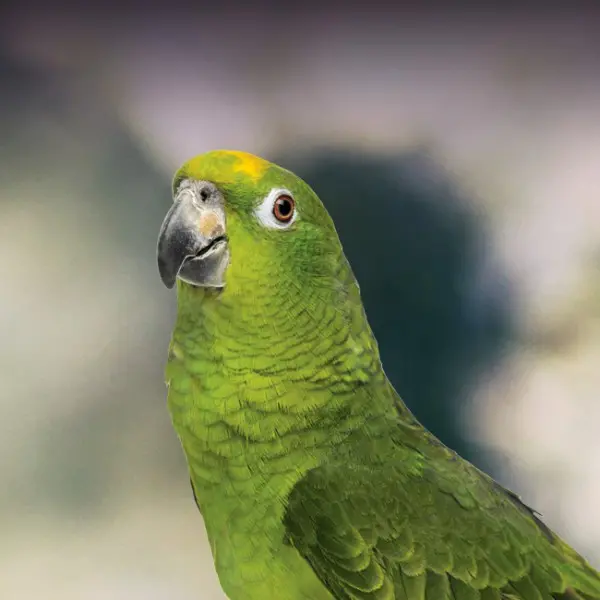
Characteristics of Amazon Parrots
Amazon parrots possess a range of characteristics that not only contribute to their charm but also impact their needs as pets. These birds are renowned for their vibrant plumage, predominantly featuring striking green feathers adorned with accents of blue, yellow, or orange. It’s not just their colorful feathers that make them stand out; Amazon parrots have a strong, compact build with a robust beak that allows them to crack tough seeds and nuts in their diet. Their zygodactyl feet, with two toes facing forward and two backward, serve them well for grasping branches and climbing during their natural activities.
Unique Features and Physical Characteristics
- Size and Weight: Amazon parrots vary in size, typically ranging from 10 to 20 inches (25 to 51 cm). The average size for many species hovers around 12 to 15 inches (30 to 38 cm). In terms of weight, they usually fall within the 6 to 22-ounce (170 to 620 grams) range, with most species averaging between 11 to 15 ounces (311 to 425 grams).
- Coloration and Subspecies: Each species of Amazon parrot showcases unique color patterns, enhancing their individual beauty and identity. For instance, the Yellow-naped Amazon displays a striking yellow patch on its nape and the Blue-fronted Amazon features a vibrant blue forehead.
- Vocalization and Intelligence: Amazon parrots are often considered the talking champions among parrot species due to their ability to mimic human speech and various sounds, drawing comparisons to a child learning language. They require mental stimulation to prevent boredom, which can lead to negative behaviors.
- Lifespan: With proper care, Amazon parrots can live long, healthy lives, often reaching 40 to 100 years, depending on the species and the environment they are kept in.
Together, these characteristics highlight the captivating nature of Amazon parrots while emphasizing the importance of understanding their specific needs to maintain their physical and emotional well-being.
Summary Table of Amazon Parrot Characteristics
| Feature | Details |
|---|---|
| Size | 10 to 20 inches (25 to 51 cm) |
| Weight | 6 to 22 ounces (170 to 620 grams) |
| Coloration | Predominantly green with various accents |
| Lifespan | 40 to 100+ years |
| Vocalization Ability | Highly capable of mimicking sounds |
Size and Weight
Amazon parrots come in various sizes and weights, depending on the species. The physical dimensions of these birds not only impact their behavior but also influence their care and habitat needs. For instance, size can affect the type of cage they require, play areas, and even the amount of space they need for exercise and social interaction.
One key aspect of an Amazon parrot’s size is its wingspan. While many species average a length of around 12 to 15 inches (30 to 38 cm), their wings can stretch wider, necessitating adequate flight space. This ability to fly contributes to their overall health, as ample flight time significantly reduces sedentary behavior.
Breakdown of Size and Weight by Species
- Yellow-Naped Amazon:
- Size: 12 to 15 inches (30 to 38 cm)
- Weight: 1 pound (480-680 grams)
- Unique Trait: Recognized for its sociable and vocal nature.
- Blue-Fronted Amazon:
- Size: 15 to 17 inches (approximately 38 to 43 cm)
- Weight: 14 to 15 ounces (approximately 400 to 425 grams)
- Unique Trait: Known for being playful and engaging in mimicry.
- Orange-Winged Amazon:
- Size: 10 to 12 inches (approximately 25 to 30 cm)
- Weight: 11 to 12 ounces (approximately 311 to 340 grams)
- Unique Trait: Features bright orange coloration on the wings.
These size parameters underscore the importance of selecting an appropriate cage size and ensuring that there is sufficient room for these birds to engage in natural flight patterns and behaviors, particularly in a home environment.
Habitat and Distribution
Amazon parrots are widely distributed across tropical and subtropical regions of Central and South America and the Caribbean islands. Their adaptability allows them to thrive in varying habitats, including dense rainforests, wetlands, savannas, and even urban areas where food sources are available. These birds prefer areas with abundant food supply, as their diets rely heavily on fruits, nuts, seeds, and berries.
###Areas of Distribution
Amazon parrots inhabit a variety of ecosystems that include:
- Tropical Rainforests:
- These lush environments provide ample foraging opportunities and protection from predators.
- Woodlands:
- Open canopies allow for sunlight while still providing hiding spots in foliage.
- Savannas:
- These grassland habitats come alive with seasonal changes, enabling access to various food sources.
Summary Table of Habitat Preferences
| Habitat Type | Description |
|---|---|
| Tropical Rainforest | Dense forests with abundant food and cover |
| Woodlands | Open areas with varied trees for nesting |
| Savannas | Grasslands providing diverse seasonal resources |
In summary, Amazon parrots have evolved responsibilities that emphasize their adaptability to diverse habitats, promoting their survival and health. The understanding of their natural range is essential for pet owners to replicate suitable living environments while considering the behavioral needs driven by their wild ancestry.
Natural Range of Amazon Parrots
The natural range of Amazon parrots is quite extensive, covering a large geographic area from northern Mexico through Central America, down to various regions in South America, including Brazil, Venezuela, and Bolivia. Specific species have established habitats on Caribbean islands, highlighting the diverse distribution patterns that different Amazon parrot species exhibit.
Regional Breakdown:
- Northward: Amazon parrots can be found as far north as southern Mexico, thriving in climate zones where food sources are plentiful.
- Central America: The species often inhabit coastal and mountainous regions, capitalizing on tropical resources.
- South America: Their presence is spread across significant areas like the Amazon Rainforest, which provides rich ecosystems and varied foraging options.
Conservation Considerations
Despite their widespread distribution, many Amazon parrot species face habitat loss due to deforestation, illegal trapping, and other anthropogenic effects, making habitat preservation crucial for their survival. Conservation initiatives that maintain natural habitats while promoting public awareness can contribute significantly to the protection of these beloved birds.
In conclusion, the natural range of Amazon parrots is both vast and varied, illustrating their adaptability and resilience while simultaneously underscoring the need for conservation efforts to secure their future in the wild.
Types of Habitats
The types of habitats where Amazon parrots thrive are as rich and diverse as the birds themselves. Amazon parrots have evolved to inhabit a variety of environments that cater to their foraging needs and social interactions. Understanding these habitats helps reveal the vitality of interplay between their behavior, diet, and overall health.
Common Habitats:
- Tropical Rainforests: Abundant in vegetation and diverse food sources, these dense environments are prime locations for searching for fruits, nuts, and seeds. The tall trees provide necessary perching and nesting opportunities, while the understory aligns with their social foraging behavior.
- Woodlands: Open canopy woodlands allow sunlight to reach the forest floor while offering different shrubs and trees that produce food items. These habitats offer a mix of foraging possibilities and safe spots for nesting.
- Savannas: In more open terrains, Amazon parrots adapt their feeding strategies to exploit seasonal food availability. During certain times of the year, they may migrate temporarily in search of resources, showcasing their adaptability to varying habitats.
- Urban Areas: In some regions, Amazon parrots have become accustomed to urban environments, where they can find food from gardens, parks, and bird feeders. Their social structure allows them to adapt and thrive in environments altered by human presence.
Summary Table of Habitat Types
| Habitat Type | Key Features |
|---|---|
| Tropical Rainforest | Dense forests with abundant food sources |
| Woodlands | Open canopies for foraging and nesting |
| Savannas | Seasonal availability of diverse food resources |
| Urban Areas | Adaptability in gardens and parks |
The diverse habitats that Amazon parrots occupy illustrate their adaptability and intelligence, emphasizing the need for pet owners to replicate aspects of these environments to foster the well-being and happiness of these delightful birds. In captivity, naturalistic setups with varied foliage, perching options, and enriching toys can help simulate their native ecosystems, promoting enrichment and overall health.
Behavior and Social Structure
Amazon parrots are inherently social creatures, often found living in flocks that can range from small groups to larger gatherings. This social behavior plays a pivotal role in their overall health and vitality, shaping their natural interactions and establishing their social structures.
Social Dynamics
- Flock Life: In the wild, Amazon parrots have been observed forming flocks as a means to enhance their safety while foraging. Living in groups allows them to share information about food sources, warn each other of predators, and provide social support.
- Pairs and Bonding: During breeding seasons, Amazon parrots exhibit strong pair bonding with their mates, engaging in mutual grooming and displays of affection. This bond can last a lifetime, which reflects their deep social connections.
- Communication: Vocalizations are a fundamental part of their social interactions. Amazon parrots communicate through a variety of calls and sounds, enabling them to express different emotions, alert flock members to danger, or coordinate activities while foraging.
In conclusion, the behavior and social structures of Amazon parrots reflect their intelligent, engaging nature. A social environment is crucial for their health, reinforcing their instinct to form connections within a group, thus highlighting the importance of companionship and socialization for pet Amazon parrots.
Social Interactions
Social interactions among Amazon parrots are rich and varied, serving as the foundation for their behavioral well-being. Their innate social characteristics allow them to thrive in a communal environment, driving them to engage with one another through physical and vocal communication.
Group Cohesion
- Vocal Communication: Amazon parrots utilize their vocal skills to communicate effectively within their flocks. Through various calls and sounds, they can convey information about food availability, potential danger from predators, and social status among peers.
- Physical Interactions: Behaviors such as preening and playful interaction play vital roles in maintaining strong social bonds. Pair bonding becomes particularly evident during courtship displays and breeding seasons, showcasing the depth of their relationships.
- Group Dynamics: Flock sizes can fluctuate based on the availability of resources. In times of abundance, Amazon parrots may gather in larger groups, while they might break into smaller, more cohesive units during lean periods.
- Learning and Imitation: Young Amazon parrots learn social cues and behaviors from their elders, symbolizing the transfer of knowledge that is vital for survival. This learning also encompasses vocalization skills, improving their ability to mimic sounds and communicate effectively.
Amazon parrots actively seek social interaction, demonstrating intelligence and emotional depth that are essential traits for their well-being. For pet owners, understanding these social interactions can help create a fulfilling environment that caters to the natural behaviors and needs of these remarkable birds.
Communication Skills
Amazon parrots are renowned for their exceptional communication skills, characterized by their ability to mimic human speech and other sounds. This vocal prowess is not merely a party trick; it serves essential social functions both in the wild and in domestic settings.
Natural Communication Skills
- Vocal Mimicry: Amazon parrots possess a varied vocal repertoire that includes the ability to imitate human speech, animal calls, and environmental sounds. This skill can enhance their relationships with their human companions and other birds, acting as a form of social engagement.
- Variety of Calls: In the wild, Amazon parrots utilize a wide range of calls to communicate different messages, such as signaling danger, coordinating flight direction, or announcing the presence of food. Each call has a specific meaning and serves a purpose within their complex social structure.
- Contextual Understanding: These parrots demonstrate an understanding of context when using their vocal skills. For example, they may use loud calling in the presence of other Amazon parrots to assert dominance or draw attention to food, while softer tones may be used during more intimate interactions.
- Training Capabilities: When kept as pets, Amazon parrots can learn to associate words or phrases with specific actions, showcasing their intelligence and cognitive skills. Owners can cultivate this talent through consistent training techniques such as positive reinforcement.
In conclusion, the communication skills of Amazon parrots are multidimensional, reflecting not only their social nature but also their cognitive abilities. Enhancing their environment with opportunities for vocal expression and interaction is critical for enriching their lives and fostering strong bonds with their human caretakers.
Diet and Feeding Habits
Dietary requirements are essential for the health and well-being of Amazon parrots. These birds are primarily herbivorous and thrive on a diversified diet that closely mirrors their natural feeding habits found in the wild.
Nutritional Needs
Understanding their diet is crucial for any owner and encompasses various food types and balanced meals:
- Pelleted Diet: A high-quality, commercially available pelleted diet should make up about 60–70% of an Amazon parrot’s nutrition. These pellets provide essential vitamins, minerals, and nutrients critical for their overall health.
- Fresh Vegetables and Fruits: The other portion of their diet should include fresh fruits and vegetables. Fruits such as papaya, mango, and berries provide crucial vitamins, while leafy greens and vegetables like bell peppers and broccoli contribute important minerals.
- Seeds and Nuts: While Amazon parrots enjoy seeds and nuts, these should be offered sparingly. Too many high-fat foods can lead to obesity and related health issues.
- Water: Clean, fresh water should always be available to encourage hydration, and it is vital for maintaining their physical health.
Dietary Preferences Table
| Food Type | Recommended Amount |
|---|---|
| Pelleted Diet | 60–70% of daily intake |
| Fruits | 20–30% (e.g., apples, bananas, tropical fruits) |
| Vegetables | 20–30% (e.g., carrots, leafy greens, bell peppers) |
| Seeds and Nuts | Sparingly, as treats |
| Water | Fresh and clean, available daily |
Adopting a balanced diet that reflects these recommendations is essential to ensure that the Amazon parrots remain healthy and energetic, as deficiencies can lead to serious health issues. A combination of nutrition and enrichment through social and foraging opportunities can greatly enhance the bird’s quality of life.
Preferred Foods
The preferred foods of Amazon parrots vary based on individual tastes, but their natural instincts lead them to specific types of nutrition that support their health and vitality. Understanding their dietary preferences helps caregivers provide a holistic approach to their feeding habits.
Common Preferred Foods
- Fruits: Amazon parrots have a natural proclivity for sweet and juicy fruits. Here are some of their favorites:
- Mango: Offers essential vitamins and a tasty treat.
- Papaya: Rich in antioxidants and digestive enzymes.
- Berries: High in vitamin C, supporting the immune system.
- Vegetables: Many Amazon parrots enjoy various vegetables. Some popular choices include:
- Carrots: Provide nutrients like vitamin A, promoting eye health.
- Broccoli: A great source of fiber and vitamins.
- Bell Peppers: Offer a variety of colors and important phytonutrients.
- Seeds and Nuts: While they enjoy these treats, moderation is key due to high-fat content:
- Almonds: A nutritious snack that fosters bonding during feeding sessions.
- Pumpkin Seeds: Provide healthy fats essential for energy.
Summary of Preferred Foods Table
| Food Type | Examples | Nutritional Benefits |
|---|---|---|
| Fruits | Mango, papaya, berries | Vitamins, antioxidants, hydration |
| Vegetables | Carrots, broccoli, bell peppers | Fiber, vitamins, digestive health |
| Seeds/Nuts | Almonds, pumpkin seeds | Healthy fats, energy, bonding opportunities |
By incorporating a variety of preferred foods into their diet, owners can ensure that their Amazon parrots remain physically and mentally stimulated while safeguarding their long-term health.
Feeding in the Wild vs. Captivity
Feeding habits in the wild differ significantly from those of captive Amazon parrots. Understanding these differences is crucial for creating an optimal diet that mimics their natural feeding behavior as closely as possible.
In the Wild
In their natural habitats, Amazon parrots tend to consume a nutrient-rich and diverse diet, primarily made up of:
- Seasonal Fruits: Availability fluctuates with the seasons, offering a variety of flavors and nutrients.
- Seeds and Nuts: Their strong beaks allow them to crack open tough shells, accessing energy-rich seeds and nuts that most other animals struggle to eat.
- Leaves and Flowers: These form a part of their natural diet, helping them maintain a balanced intake of vitamins.
In the wild, Amazon parrots are skilled foragers, spending hours climbing trees and scouting for food. Their natural instincts drive them to seek out nutrient-dense food sources, which promote healthy growth, plumage, and overall vitality.
In Captivity
Contrastingly, the diet of captive Amazon parrots often differs, potentially leading to deficiencies. Common issues include:
- Commercial Seed Mixes: Many owners mistakenly rely on seed mixes as a staple, which can be high in fat but low in essential vitamins.
- Limited Food Variety: Easy access to a combination of pellets, fruits, and vegetables is not always replicated in captivity, restricting their nutritional intake.
To counteract these issues, caregivers should prioritize:
- Balanced Diet: Ensure the majority of the diet comprises pellets designed specifically for parrots.
- Introduce Variety: Regularly offer a rotating selection of fresh fruits and vegetables.
- Avoid Overfeeding: Monitor fat content in seeds and nuts to prevent obesity.
Summary of Feeding Habits Comparison Table
| Aspect | Wild Feeding | Captive Feeding |
|---|---|---|
| Diet Variation | Highly diverse, based on seasonal availability | Often limited; risk of overreliance on seeds |
| Foraging Behavior | Active foragers, spend hours searching for food | Less physical activity; reliance on available food |
| Nutritional Balance | Naturally balanced through diverse sources | Need for careful monitoring and diet adjustments |
Adapting a feeding plan that reflects their natural behaviors and dietary needs will help promote the long-term health of captive Amazon parrots while fostering a satisfying and enriching environment.
Care Requirements for Pet Amazon Parrots
Proper care is essential for maintaining the health and well-being of pet Amazon parrots. As social and intelligent creatures, their needs extend beyond feeding and water, requiring a comprehensive understanding of their care requirements.
Essential Care Considerations
- Cage and Environment:
- Provide a spacious cage that allows ample room for movement and activity. The minimum size should be at least 24″ x 24″ x 36″, with solid perches and toys that encourage play.
- The cage should be placed in a social area of the house to foster interaction with family.
- Social Interaction:
- Amazon parrots thrive on companionship, requiring at least 3 to 4 hours of supervised time outside their cage for social interactions and exercise.
- Engage in regular playtime and training sessions to strengthen the bond and fulfill their social needs.
- Diet Monitoring:
- Consistently evaluate the quantity and type of food offered daily. Fresh fruits, vegetables, and a high-quality pellet should be staples in their diet.
- Regularly change water, ensuring they have access to clean and fresh hydration at all times.
- Health Check-Ups:
- Conduct yearly visits to an avian veterinarian to address potential health issues and ensure overall well-being.
- Monitoring for signs of illness such as lethargy, loss of appetite, or behavioral changes is crucial.
- Mental Stimulation:
- Incorporate various toys, puzzles, and activities to prevent boredom. Rotate toys regularly to maintain interest and engagement.
Summary of Care Requirements Table
| Care Component | Recommendations |
|---|---|
| Cage Size | Minimum 24″ x 24″ x 36″ |
| Social Time | 3 to 4 hours outside the cage daily |
| Diet | Balanced diet with pellets, fruits, and vegetables |
| Health Check-Ups | Annual vet visits for health monitoring |
| Mental Stimulation | Variety of toys and activities rotated regularly |
Providing pet Amazon parrots with a supportive and engaging environment centered around their specific care requirements enhances their quality of life, ensuring they remain healthy and happy companions.
Housing and Environment
Creating an appropriate housing setup is crucial for Amazon parrots, as it directly influences their comfort and well-being. The environmental aspects of their housing must cater to their natural behaviors, enabling them to thrive in captivity.
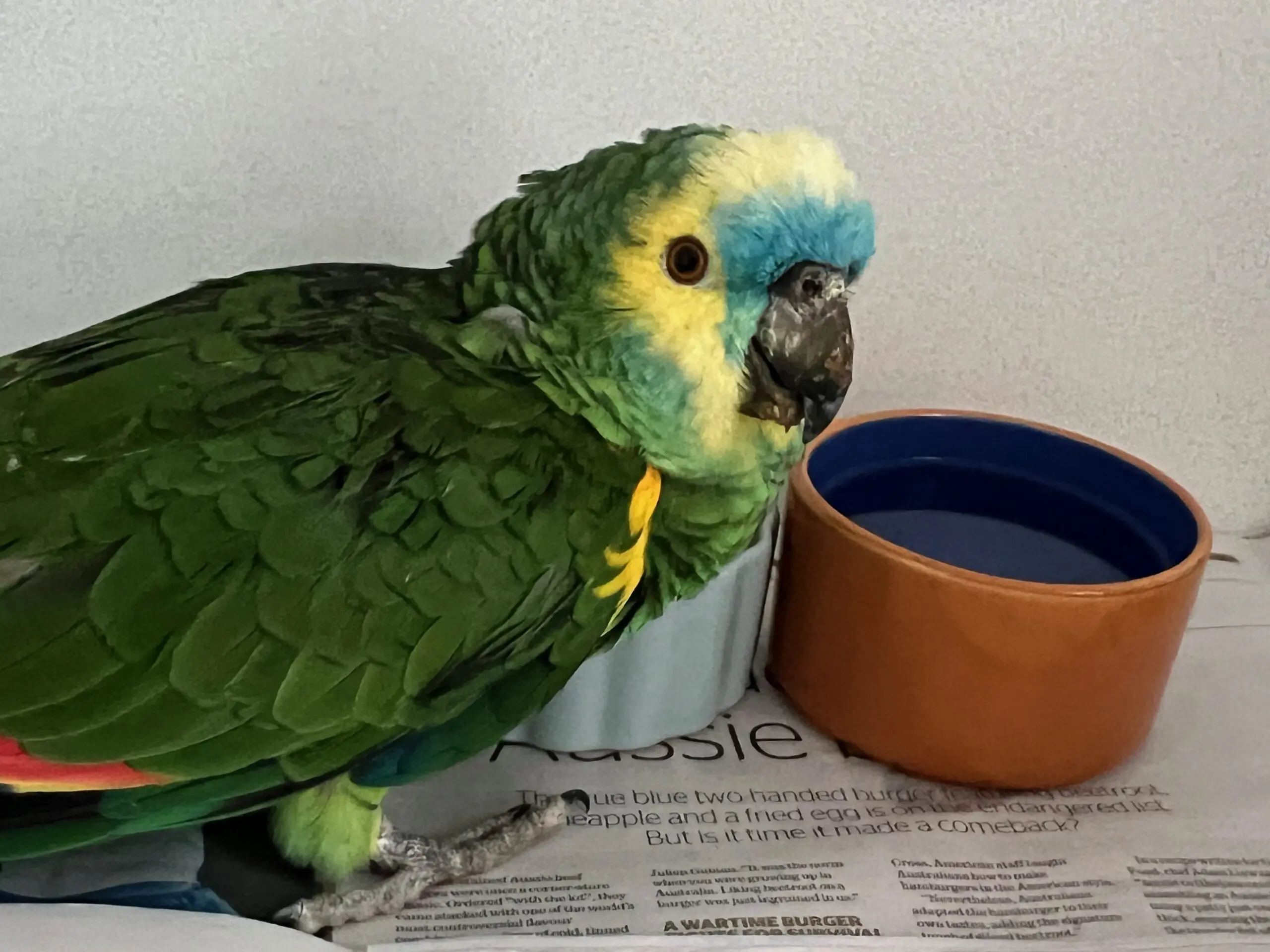
Housing Considerations
- Cage Size and Design:
- Choose a large cage that allows the parrot to stretch its wings and move freely. The cage should be at least 24″ x 24″ x 36″, although larger is preferable for the active nature of Amazon parrots.
- Ensure the bars are sturdy and widely spaced enough to prevent escape, usually between 0.5 to 1 inch apart.
- Perches and Toys:
- Equip the cage with multiple perches of diverse sizes and textures to promote foot health and provide opportunities for climbing and exploration.
- Include various engaging toys such as foraging toys, chew toys, and puzzle toys that stimulate their intellect.
- Environmental Enrichment:
- Position the cage in a household area where the parrot can observe daily activities, fostering social interaction and reducing feelings of isolation.
- Rotate toys and perches regularly to prevent boredom and sustain their interest.
- Bedding and Substrate:
- Use a non-toxic, absorbent substrate in the cage to maintain cleanliness, replacing it frequently to prevent the buildup of bacteria or odors.
- Safe Zones and Play Areas:
- Designate areas outside of the cage where the bird can safely explore. Use playstands or harnesses to encourage interaction while ensuring their safety.
Summary of Housing Environment Table
| Housing Component | Description and Best Practices |
|---|---|
| Cage Size | Minimum of 24″ x 24″ x 36″ |
| Perches | Multiple sizes and textures for climbing |
| Toys | Engaging and varied toys for mental stimulation |
| Bedding | Non-toxic, absorbent substrate |
| Social Interaction | Placement in active household areas |
By building an environment that mirrors their natural habitats and provides space for exercise and interaction, pet owners can ensure Amazon parrots not only survive but flourish in their care.
Health and Veterinary Care
Health and veterinary care are fundamental components of responsible Amazon parrot ownership. A proactive approach toward their health can prevent numerous issues and enhance their quality of life.
Health Considerations
- Regular Check-Ups:
- Schedule annual visits to an avian veterinarian for comprehensive health examinations, including weight checks, blood tests, and assessments for potential diseases or deficiencies.
- Discuss any dietary changes, unusual behaviors, or signs of illness with the veterinarian during these visits.
- Preventive Care:
- Maintain proper husbandry practices to prevent common health problems such as obesity, which can lead to further complications. Monitor their diet to ensure a balanced intake.
- Grooming, including nail trimming and beak care, is essential to ensure comfort and health.
- Behavioral Management:
- Engage in positive reinforcement training and social interaction to mitigate behavioral issues. Regular interaction reduces anxiety and establishes a trusting relationship.
- Signs of Health Problems:
- Be vigilant for signs of distress, such as changes in appetite, lethargy, or abnormal droppings. Seek prompt veterinary advice for any concerning symptoms.
- Diet and Nutrition Checks:
- Conduct regular assessments to ensure the diet remains nutrient-rich and balanced, adapting as the parrot ages or requires adjustments based on health needs.
Summary of Health and Veterinary Care Table
| Health Component | Recommendations |
|---|---|
| Regular Check-Ups | Annual veterinary visits for health monitoring |
| Preventive Care | Proper husbandry to avoid obesity and other issues |
| Behavioral Management | Socialization and training to mitigate negative behaviors |
| Signs of Health Problems | Monitoring for notable changes in behavior or health |
Ensuring comprehensive health care, veterinary attention, and preventive measures are pivotal in maintaining the overall well-being of Amazon parrots, which will result in happier and healthier birds.
Breeding and Reproduction
Breeding and reproduction in Amazon parrots involve intricate behaviors and social dynamics that can be fascinating to observe. Understanding these natural processes is essential for ensuring their welfare in captivity and fostering proper breeding practices.
Mating Rituals
- Courtship Displays:
- Males often engage in elaborate courtship rituals to attract females, incorporating vocalizations, feather displays, and feeding behaviors to showcase their ability to provide.
- These rituals strengthen pair bonds by enhancing trust between partners.
- Bonding Behaviors:
- During the breeding season, Amazon parrots exhibit mutual preening, feeding, and vocal exchanges to affirm their bond, vital for successful reproductive outcomes.
- Nest Preparation:
- Secure nest sites are critical for the breeding process. Amazon parrots usually search for tree cavities or suitable nest boxes. The female prepares the nesting area, making it safe and comfortable for egg-laying.
Nesting and Egg Laying
- Clutch Size and Incubation:
- Clutch sizes typically range from two to six eggs, depending on the species. The female incubates the eggs, while the male provides food and support during this critical period.
- Chick Development:
- After the eggs hatch, the altricial chicks depend entirely on their parents for food and care. Both parents often participate in feeding their young until they reach independence.
- Lifespan and Maturity:
- Young Amazon parrots become independent at around 8 to 12 weeks but may continue to rely on their parents for guidance even longer. They reach sexual maturity at 4 to 6 years of age.
Summary of Breeding and Reproduction Table
| Aspect | Description |
|---|---|
| Courtship Displays | Vocalizations and rituals to attract mates |
| Bonding Behaviors | Mutual preening and feeding to reinforce connection |
| Clutch Size | Typically 2 to 6 eggs; incubation by female |
| Chick Care | Parental involvement until independence |
Observing the breeding behaviors of Amazon parrots offers a window into the complexity and intelligence of these remarkable birds, underscoring the importance of addressing their needs during this period, whether in the wild or in domestic settings.
Nesting Habits
Nesting habits in Amazon parrots reflect their natural instincts and social complexity. Understanding these habits is integral to ensuring successful reproduction and providing suitable environments for pet birds when they are expected to breed.
Nesting Behavior
- Nest Site Selection:
- Amazon parrots typically seek out tree cavities or hollow logs as safe nesting sites. This instinct drives them to find secure places, offering protection from predators and environmental hazards.
- Nesting Materials:
- In the wild, they may utilize natural materials found within their environment to create a comfortable nesting area, including leaves, twigs, and moss.
- Egg-Laying Process:
- The female lays eggs a few days apart, ensuring a staggered hatching schedule. This method provides flexibility in parental care for the chicks once hatched.
Care of Nestlings
- Parental Involvement:
- Both male and female parrots are typically involved in caring for the nestlings. They regurgitate food, offering nutritional supplements essential for the young birds’ growth.
- Development Stages:
- After hatching, chicks are altricial blind, featherless, and helpless. The parents provide warmth and food until the chicks grow feathers and reach independence.
- Post-Fledging Care:
- Young birds may remain with their parents for several weeks after fledging, learning essential survival skills through observation and interaction within the family unit.
Summary of Nesting Habits Table
| Aspect | Description |
|---|---|
| Site Selection | Tree cavities or hollow logs for safety |
| Nesting Materials | Leaves, twigs, and natural materials |
| Egg Laying Process | Staggered laying for flexible care |
| Parental Care | Both parents involved in feeding and raising young |
Understanding the nesting habits of Amazon parrots allows pet owners and breeders to create conditions that mimic natural behaviors, thereby enhancing the health and comfort of the birds during critical reproductive phases.
Popular Amazon Parrot Species
Certain Amazon parrot species are particularly popular among avian enthusiasts and pet owners due to their engaging personalities and sociability. Two of the most commonly sought-after species are the Yellow-naped Amazon and the Blue-fronted Amazon, each boasting unique traits that make them appealing companions.
Overview of Popular Species:
- Yellow-Naped Amazon Parrot:
- Known for its vibrant personality and exceptional mimicry, the Yellow-naped Amazon is a medium-sized parrot that can live for several decades when provided with proper care. Their affectionate nature often leads them to form strong bonds with family members.
- Blue-Fronted Amazon Parrot:
- Recognized for its intelligence and playful demeanor, the Blue-fronted Amazon engages in vocal mimicry and can learn a vast range of words and commands. Their social nature and adaptability make them fitting companions for families and enthusiasts alike.
Summary Table of Popular Amazon Parrot Species
| Species | Characteristics |
|---|---|
| Yellow-Naped Amazon | Excellent talkers, vibrant personalities, affectionate |
| Blue-Fronted Amazon | Playful, intelligent, capable of complex mimicry |
These popular species embody the spirited nature of Amazon parrots while emphasizing the importance of responsible ownership. Prospective owners should be aware of their social and dietary needs to ensure a fulfilling life for these avian companions.
Yellow-Naped Amazon Parrot
The Yellow-naped Amazon parrot (Amazona auropalliata) is widely recognized for its distinct charm and striking appearance. Native to Central America, these parrots are notable for their striking coloration and impressive vocal abilities.
Characteristics
- Physical Traits:
- Typically measuring between 12 to 15 inches (30 to 38 cm), they are predominantly green with a characteristic patch of bright yellow on the back of their neck. This vibrant coloration draws attention and enhances their appeal.
- Lifespan:
- With proper care, these parrots can live exceptionally long lives, often exceeding 60 years in captivity.
- Diet:
- Yellow-naped Amazons thrive on a balanced diet, consisting of high-quality pellets, fresh fruits, and vegetables, which contribute to their overall health and well-being.
- Behavior and Social Interaction:
- This species is highly social and affectionate, often seeking interaction with its owner. They are known for their talking ability, showcasing advanced vocal skills that can range from mimicking human speech to imitating household sounds.
- Conservation Status:
- The Yellow-naped Amazon is classified as Critically Endangered due to habitat loss and the ongoing threat of capture for the illegal pet trade. Preserving their habitats and supporting responsible breeding practices is essential for their survival.
Summary of Yellow-Naped Amazon Characteristics Table
| Characteristic | Details |
|---|---|
| Size | 12 to 15 inches (30 to 38 cm) |
| Weight | 1 pound (480-680 grams) |
| Lifespan | Up to 60+ years |
| Diet | Pellets, fruits, and vegetables |
| Talking Ability | Excellent mimickers and vocalizers |
| Conservation Status | Critically Endangered |
In recognizing the appeal of the Yellow-naped Amazon, prospective owners must consider their care requirements, fostering an enriching environment that meets their social, dietary, and healthy living needs.
Blue-Fronted Amazon Parrot
The Blue-fronted Amazon parrot (Amazona aestiva) is another popular species known for its striking appearance, captivating personality, and exceptional vocal skills. These parrots are often characterized by their playful and social nature, making them a favorite among avian enthusiasts.
Characteristics
- Physical Traits:
- Ranging from 15 to 17 inches (approximately 38 to 43 cm) in length, Blue-fronted Amazons display a vibrant green plumage highlighted by a blue crown and forehead. This combination of colors makes them visually stunning.
- Lifespan:
- With proper care, Blue-fronted Amazons can live for 40 to 100 years, reflecting the need for long-term commitment from owners.
- Diet:
- A balanced diet consisting of high-quality pellets, fresh fruits, vegetables, seeds, and nuts is essential to meet their nutritional needs.
- Behavior and Social Interaction:
- Highly sociable and intellectually sharp, Blue-fronted Amazons are known for their ability to learn a diverse range of words and commands. Their playful demeanor allows them to blend seamlessly into family life.
- Conservation Status:
- While not classified as critically endangered, Blue-fronted Amazons face threats from habitat loss and capture for the pet trade. Responsible ownership and adherence to conservation practices play important roles in their protection.
Summary of Blue-Fronted Amazon Characteristics Table
| Characteristic | Details |
|---|---|
| Size | 15 to 17 inches (approximately 38 to 43 cm) |
| Weight | 14 to 15 ounces (approximately 400 to 425 grams) |
| Lifespan | 40 to 100+ years |
| Diet | Pellets, fruits, vegetables, seeds, and nuts |
| Talking Ability | Skilled mimickers with vast vocabularies |
| Conservation Status | At risk due to habitat loss and pet trade |
Choosing to bring a Blue-fronted Amazon parrot into one’s home entails understanding their needs and providing an animal-friendly environment that nurtures their intelligence, companionship, and vibrant living.
Training and Enrichment
Training and enrichment are integral aspects of caring for Amazon parrots, given their intelligence and social nature. Engaging these birds through mental and physical challenges fosters a fulfilling life while encouraging healthy behaviors.
Training Techniques
- Positive Reinforcement Methods:
- Use treats, praises, and affection to reward desired behaviors. This method creates a positive association and encourages parrots to repeat specific actions.
- Consistent Commands:
- Employ the same words or phrases for commands to build recognition and understanding over time. Building a routine enhances comfort and reduces anxiety.
- Short and Engaging Sessions:
- Keep training sessions between 5 to 15 minutes. Short intervals maintain focus and prevent boredom while maximizing retention.
- Target Training:
- Introduce target training by teaching the parrot to touch a stick. This exercise can serve as a foundation for guiding them through various activities and tricks.
- Socialization:
- Engage in various activities with different people to enhance adaptability and comfort level with humans.
Enrichment Techniques
- Environmental Stimulation:
- Rotate toys and introduce new elements regularly to maintain interest and promote exploration.
- Puzzle Toys:
- Provide toys that mimic foraging behaviors, encouraging both mental stimulation and physical engagement.
- Interactive Play:
- Spend quality time playing and interacting outside the cage, allowing for physical exercise and strengthening the owner-bird bond.
- DIY Enrichment Activities:
- Create homemade toys or activities using common household items. For example, hiding treats in paper towel rolls stimulates natural foraging instincts.
- Bathing Opportunities:
- Regular access to bathing or misting helps maintain feather health while also providing a fun activity.
Summary of Training and Enrichment Table
| Training/Enrichment Component | Learning Strategies |
|---|---|
| Positive Reinforcement | Treats, praises, and affection |
| Consistent Commands | Same words for recognizable training |
| Short Sessions | 5 to 15 minutes for focus |
| Environmental Stimulation | Rotate toys, introduce new items continuously |
| Puzzle Toys | Engage intellect and promote natural behaviors |
| Interactive Play | Strengthen bond through playtime |
Effectively incorporating training and enrichment into the daily life of an Amazon parrot not only enhances their mental stimulation and social interaction but also fosters a deeper bond with their human companions.
Importance of Mental Stimulation
Mental stimulation is paramount for Amazon parrots, given their high intelligence and complex social structures. Engaging activities that challenge their minds prevent boredom and help maintain behavioral health.
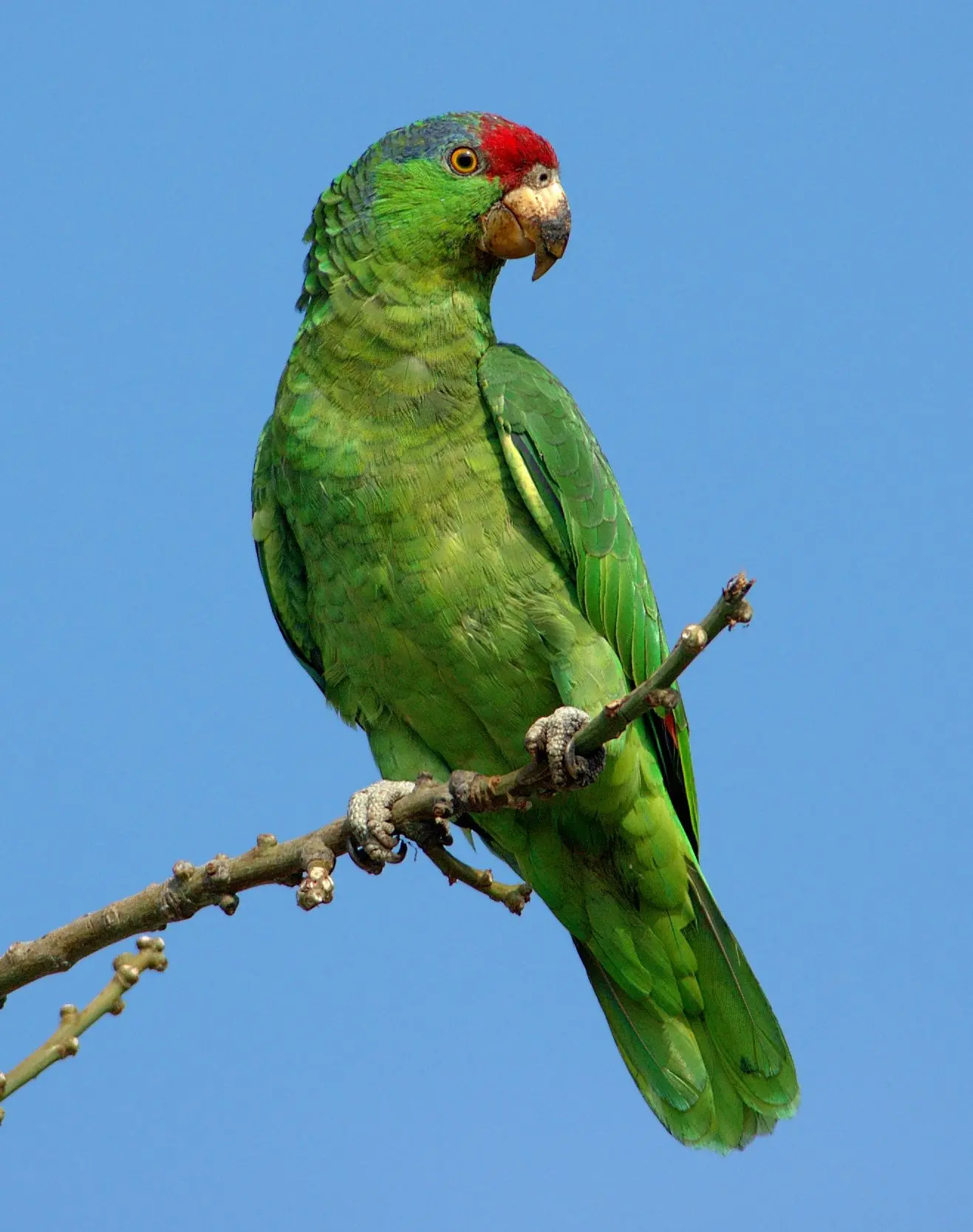
Reasons for Mental Stimulation
- Cognitive Development:
- Amazon parrots exhibit cognitive abilities akin to a 3-5 year old child, necessitating daily challenges to keep their minds sharp. Engaging in training and providing enrichment activities support cognitive health.
- Behavioral Benefits:
- Positive reinforcement training helps decrease stress, promotes teamwork, and fosters good conduct. This dual purpose of entertainment and psychological well-being is essential for their development.
- Physical Activity:
- Mental stimulation often coincides with physical play. Activities like foraging and toy interaction encourage movement, crucial for preventing obesity and maintaining overall physical health.
- Emotional Health:
- Just as safety is vital for physical health, mental well-being is crucial for emotional stability. Constant engagement with their environment fosters positivity and emotional contentment.
Summary of Importance of Mental Stimulation Table
| Benefit | Explanation |
|---|---|
| Cognitive Development | Daily challenges keep minds sharp |
| Behavioral Benefits | Reduces stress and promotes good behavior |
| Physical Activity | Encourages movement and prevents obesity |
| Emotional Health | Positive interactions enhance overall emotional well-being |
Overall, prioritizing mental stimulation through varied interactions and activities is essential for promoting the health and happiness of Amazon parrots, nurturing their natural tendencies while fostering strong relationships with humans.
Common Misconceptions About Amazon Parrots
Despite their popularity, several misconceptions about Amazon parrots persist, primarily concerning their care, behavior, and specific needs. Recognizing these myths is crucial for ensuring their well-being as companion animals.
Common Myths vs. Facts
- Myth: Amazon Parrots Are Easy to Care For
- Fact: Amazon parrots require significant attention, social interaction, and proper care. They are not suitable for owners unable to dedicate time to their needs.
- Myth: They Will Automatically Bond With You
- Fact: Establishing trust and connection takes consistent interaction and effort. Owners must engage the parrot regularly to foster a strong relationship.
- Myth: All Amazon Parrots Talk Well
- Fact: While many have potential for vocal mimicry, this varies significantly by individual, and not all will become fluent talkers.
- Myth: Parrots Only Need Food and Water
- Fact: Environmental stimulation is critical. Beyond food and water, they need toys, social interaction, and mental challenges to thrive.
- Myth: Loudness is Their Only Trait
- Fact: While Amazon parrots can be noisy, they are affectionate, intelligent creatures capable of forming deep bonds with their caretakers.
Summary of Misconceptions Table
| Myth | Fact |
|---|---|
| Easy Care | Requires significant attention and interaction |
| Automatic Bonding | Trust takes time and consistent effort |
| All Talk Well | Individual vocal abilities vary significantly |
| Only Need Food/Water | Require social interaction and environmental stimulation |
| Only Noisy | Affectionate and intelligent, capable of deep bonds |
By addressing these misconceptions and understanding the true needs of Amazon parrots, caregivers can provide a more enriching and supportive environment, ensuring their avian companions live a fulfilled and healthy life.
Myths vs. Facts
Understanding the differences between myths and facts regarding Amazon parrots is important for prospective owners. Learning and debunking these misconceptions fosters responsible care practices.
Myths and Related Facts
- Myth: Amazon Parrots Are Silent Companions
- Fact: These birds are naturally vocal and can create substantial noise. Owners should be prepared for their calls, as they enjoy expressing themselves.
- Myth: They Can Be Left Alone for Extended Periods
- Fact: Social creatures, Amazon parrots require regular interaction. Leaving them alone for long periods can lead to depression and undesirable behaviors.
- Myth: All Amazon Parrots Can Be Taught Complex Tricks
- Fact: Each parrot has unique skills and personalities. While many can learn, not all will master complex tasks, and individual learning speeds may vary.
- Myth: Parrots Aren’t Affectionate
- Fact: Many Amazon parrots are known for their strong bonds with their caregivers and can exhibit affection through preening, snuggling, and hung friendly interactions.
- Myth: Only Experienced Bird Owners Can Care for Amazon Parrots
- Fact: While prior experience can aid in care, first-time owners can also provide a loving home as long as they are dedicated to learning about the needs of Amazon parrots.
Summary of Myths vs. Facts Table
| Myth | Fact |
|---|---|
| Silent Companions | Naturally vocal and expressive |
| Left Alone for Long Periods | Require social interaction and regular presence |
| All Learn Complex Tricks | Individual skills and learning speeds vary |
| Aren’t Affectionate | Form strong bonds with caregivers |
| Only Experienced Owners | First-time owners can provide loving homes |
By clarifying these myths and acknowledging the facts, owners can become more informed and equipped to cater to the unique needs of Amazon parrots, leading to healthier and happier birds.
Understanding Their Needs
Understanding the specific needs of Amazon parrots is vital for successful ownership. As intelligent and social beings, these birds require holistic care that addresses their physical, emotional, and psychological well-being.
Key Aspects of Their Needs
- Social Interaction:
- Amazon parrots thrive on companionship and require daily social engagement. Owners should prioritize interaction, playtime, and even opportunities for training to fulfill their social needs.
- Physical Space:
- Ample housing space is necessary to accommodate their active nature. Providing a spacious cage with room for flight and perch options enables continued well-being.
- Mental Enrichment:
- Engaging activities, enrichment toys, and opportunities for foraging play a vital role in keeping their minds sharp, reducing anxiety, and preventing boredom-related behaviors.
- Balanced Diet:
- Nutritional needs must be met through a balanced diet of pellets, fruits, and vegetables. Regular diet assessments help maintain health and prevent issues such as obesity.
- Routine Health Care:
- Regular veterinary check-ups and preventive care are essential in maintaining health and addressing potential issues before they become critical.
Summary of Understanding Their Needs Table
| Need | Explanation |
|---|---|
| Social Interaction | Daily engagement through play and training |
| Physical Space | Spacious cages for flight and exercise |
| Mental Enrichment | Engaging activities and toys |
| Balanced Diet | Nutritional intake of pellets, fruits, vegetables |
| Routine Health Care | Regular vet visits and preventive measures |
By addressing the unique needs of Amazon parrots and recognizing the importance of social interaction, mental stimulation, and proper nutrition, caregivers can create a nurturing environment that supports their physical and emotional health. This understanding fosters a lifelong bond between pet owners and their vibrant avian companions, ensuring both parties enjoy the benefits of a rewarding relationship.
In conclusion, owning an Amazon parrot comes with its challenges and joys. These intelligent and social birds require dedicated attention, careful care, and a supportive environment to flourish. By understanding their characteristics, habitats, behaviors, dietary needs, and the common misconceptions surrounding them, prospective owners can provide loving homes that cater to their unique requirements. It is vital to approach ownership with a sense of responsibility, commitment, and willingness to learn, ensuring that these captivating birds lead happy and healthy lives as cherished members of the family.


